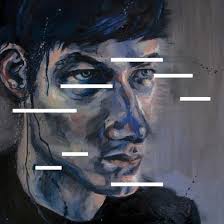Viewed in a MIDI software sequencer, the rectangular blocks that represent programmed notes always look so clunky and graceless compared to the music they encode. Essentially instructions to the instruments the sequencer is plugged into, their squared-off look seems to represent everything naysayers might once have had you believe about digital music: cold and calculated, overworked, lacking in spontaneity, flexibility and the human touch. In 2014, of course, those notions now seem as quaint and outdated as the bleep-screech-whirr of a 56k modem connection. William Doyle’s choice to scatter MIDI notes across the cover art for his debut album as East India Youth, Total Strife Forever, seems calculated to emphasise that fact: the music contained within is so lusciously textured, so intricately detailed and considered, as to make those rectangular blocks seem absurdly simplistic by comparison.
Yet Total Strife Forever does feel like a distinctly digital album, and its strengths lie in the way that it plays with that, often to striking emotional effect. Now that plenty of us spend significant portions of our lives mediated by the flat, cool glare of a laptop screen, I often find myself wondering how pop music might end up reflecting those bouts of semi-aloneness, and the contradictory impulses they stir up in mind and body. Essentially an articulate, smart and expressive orchestral pop album cast in glacial, overtly synthetic tones, Total Strife Forever finds Doyle – who recorded it in the months following his former band’s break up, while ensconced in a flat in London’s Docklands – drawing subtle but affecting parallels between solipsistic data immersion and actual bodily, physical and emotional experiences of isolation and depression.
Indeed, all sorts of musical references spring to mind across the course of Total Strife Forever, but they’re not only the Berlin-era Bowie, Philip Glass, Sufjan Stevens, Brian Eno and Neu! calling cards mentioned by Doyle and critics alike. It also brings to mind a host of contemporary electronic music that imagines a kind of freaky, unsettlingly beautiful digital psychedelia: later Zomby’s nighttime wanderings through CGI forests, the tense power struggles between human voice and synthetic environment of Laurel Halo’s Quarantine, the grime-inspired chilly synth-drifts of Visionist.
Long distances between vocal tracks heighten this effect; despite Doyle’s keen ear for a hook, there are only four on here, and Total Strife Forever‘s predominantly instrumental nature and searching mood lend the album the feeling of a journey inwards. The acoustic piano arpeggios of opener ‘Glitter Recession’ gradually harden into a vortex of shivering synth notes, with the whole piece gradually descending into deep blue permafrost across five minutes. ‘Midnight Koto”s melodies drop like pinpricks into the data sea, each one sending ripples rebounding out into the distance like drops of water into a suikinkutsu. The four ‘Total Strife Forever’ tracks scattered around the album possess the mood of a solo wander through beautiful, depopulated territories, where shards of effected guitar and delicate, splintered notes evoke an inner landscape of crystal towers, frost-encrusted railway lines and rolling fields of razor-edged grass. But there’s still warmth: when, four and a half minutes through ‘Total Strife Forever I’, a great riptide of hot, seething distortion curls up through the mix, the effect is blissful – the entire piece seems to glow, as if warmed by orange rays of sun on a chilly morning.
Amid this pristine world, ‘Heaven, How Long’ is both midpoint and dizzying highlight. Above a zooming, immaculately catchy synth-pop lead line, and amid talk of "valerian awakenings" and "amitriptylene evenings", Doyle’s voice cracks and bleeds around the edges, his sibilants turned to freezing fog by carefully applied bursts of reverb. Even as it accelerates to its euphoric, beatless climax, he appears to be dissolving into his surroundings, becoming progressively more disembodied until the ground drops away entirely, then the song finally explodes into a harsh, motorik chug and squalls of guitar noise. Taken alone it’s a beautiful and compulsively replayable pop song – it has lost none of its power since it was released on Doyle’s Hostel EP (also the debut 12" released through The Quietus’ record label) – but in the context of the album’s long stretches of contemplation it’s revealed as something entirely weirder and more haunting.
The same is true of the rest of the album’s songs, and the way Doyle’s lyrics, while open to interpretation, often feel as though they’re being sung as mantras to himself. ‘Dripping Down’ plays like an incitement to action, beginning life at "glacial pace" before its chorus plunges into delirious, joyous freefall. Later, ‘Looking For Someone’s "looking for someone, I don’t know where they are" could be read as desire for contact with other humans, yet Doyle abruptly flips the tone a couple of lines later, hinting that he might actually be attempting to get a handle upon his own diffuse psyche: "just for me and no-one else / I need something for myself". In the context even the title, Total Strife Forever, feels conflicted, both celebratory and darkly witty.
Despite their ambiguous sentiments, these songs, studded throughout the album’s length, betray a straightforward pop sensibility that feels refreshing in the sonic world they’re placed within. As a result, one of the most striking things about this strange and idiosyncratic record is how not-strange it feels. That, along with Doyle’s very contemporary refusal to impose dividing lines between the musical styles he’s interested in – shoegaze and orchestral pop rubbing shoulders with ambient music and even, on ‘Hinterland’, fuzzed-out techno – makes Total Strife Forever that most welcome of things: an often fairly classicist pop record which nods heavily towards naggingly familiar influences, yet doesn’t feel like it could exist at any other time than now.


